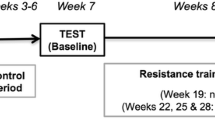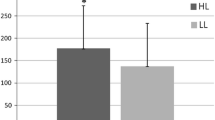Abstract
Resistance training has been shown to considerably increase strength and neural drive during maximal eccentric muscle contraction; however, less is known about the adaptive change induced by subsequent detraining. The purpose of the study was to examine the effect of dynamic resistance training followed by detraining on changes in maximal eccentric and concentric isokinetic muscle strength, as well as to examine the corresponding adaptations in muscle cross-sectional area (CSA) and EMG activity. Maximal concentric and eccentric isokinetic knee extensor moment of force was measured in 13 young sedentary males (age 23.5±3.2 years), before and after 3 months of heavy resistance training and again after 3 months of detraining. Following training, moment of force increased during slow eccentric (50%, P<0.001), fast eccentric (25%, P<0.01), slow concentric (19%, P<0.001) and fast concentric contraction (11%, P<0.05). Corresponding increases in EMG were observed during eccentric and slow concentric contraction. Significant correlations were observed between the training-induced changes in moment of force and EMG (R2=0.33–0.77). Muscle CSA (measured by MRI) increased by 10% (P<0.001). After 3 months of detraining maximal muscle strength and EMG remained preserved during eccentric contraction but not concentric contraction. The present findings suggest that heavy resistance training induces long-lasting strength gains and neural adaptations during maximal eccentric muscle contraction in previously untrained subjects.



Similar content being viewed by others
References
Aagaard P, Thorstensson A (2002) Neuromuscular aspects of exercise—adaptive responses evoked by strength training. In: Kjær M (ed) Textbook of sport medicine. Blackwell, London, pp 70–106
Aagaard P, Simonsen EB, Trolle M, Bangsbo J, Klausen K (1995) Isokinetic hamstring/quadriceps strength ratio: influence from joint angular velocity, gravity correction and contraction mode. Acta Physiol Scand 154:421–427
Aagaard P, Simonsen EB, Trolle M, Bangsbo J, Klausen K (1996) Specificity of training velocity and training load on gains in isokinetic knee joint strength. Acta Physiol Scand 156:123–129
Aagaard P, Simonsen EB, Andersen JL, Magnusson SP, Halkjaer-Kristensen J, Dyhre-Poulsen P (2000) Neural inhibition during maximal eccentric and concentric quadriceps contraction: effects of resistance training. J Appl Physiol 89:2249–2257
Aagaard P, Andersen JL, Dyhre-Poulsen P, Leffers AM, Wagner A, Magnusson SP, Halkjaer-Kristensen J, Simonsen EB (2001a) A mechanism for increased contractile strength of human pennate muscle in response to strength training: changes in muscle architecture. J Physiol 534:613–623
Aagaard P, Simonsen EB, Andersen JL, Leffers AM, Wagner A, Magnusson SP, Halkjaer-Kristensen J, Dyhre-Poulsen P (2001b) MRI assessment of quadriceps muscle size before and after resistance training: determination of volume vs single-site CSA. Med Sci Sports Exerc 33: S147
Aagaard P, Simonsen EB, Andersen JL, Magnusson P, Dyhre-Poulsen P (2002) Neural adaptation to resistance training: changes in evoked V-wave and H-reflex responses. J Appl Physiol 92:2309–2318
Abbruzzese G, Morena M, Spadavecchia L, Schieppati M (1994) Response of arm flexor muscles to magnetic and electrical brain stimulation during shortening and lengthening tasks in man. J Physiol 481(Pt 2):499–507
Amiridis IG, Martin A, Morlon B, Martin L, Cometti G, Pousson M, Van Hoecke J (1996) Co-activation and tension-regulating phenomena during isokinetic knee extension in sedentary and highly skilled humans. Eur J Appl Physiol Occup Physiol 73:149–156
Bawa P (2002) Neural control of motor output: can training change it? Exerc Sport Sci Rev 30:59–63
Bawa P, Chalmers GR, Jones KE, Sogaard K, Walsh ML (2000) Control of the wrist joint in humans. Eur J Appl Physiol 83:116–127
Caiozzo VJ, Perrine JJ, Edgerton VR (1981) Training-induced alterations of the in vivo force-velocity relationship of human muscle. J Appl Physiol 51:750–754
Colliander EB, Tesch PA (1990) Effects of eccentric and concentric muscle actions in resistance training. Acta Physiol Scand 140:31–39
Colliander EB, Tesch PA (1991) Responses to eccentric and concentric resistance training in females and males. Acta Physiol Scand 141:149–156
Colliander EB, Tesch PA (1992) Effects of detraining following short term resistance training on eccentric and concentric muscle strength. Acta Physiol Scand 144:23–29
Crago PE, Houk JC, Rymer WZ (1982) Sampling of total muscle force by tendon organs. J Neurophysiol 47:1069–1083
Day SJ, Hulliger M (2001) Experimental simulation of cat electromyogram: evidence for algebraic summation of motor-unit action-potential trains. J Neurophysiol 86:2144–2158
Dudley GA, Harris RT, Duvoisin MR, Hather BM, Buchanan P (1990) Effect of voluntary vs artificial activation on the relationship of muscle torque to speed. J Appl Physiol 69:2215–2221
Gregory JE, Proske U (1979) The responses of Golgi tendon organs to stimulation of different combinations of motor units. J Physiol 295:251–262
Hakkinen K, Komi PV (1983) Electromyographic changes during strength training and detraining. Med Sci Sports Exerc 15:455–460
Hakkinen K, Alen M, Komi PV (1985) Changes in isometric force- and relaxation-time, electromyographic and muscle fibre characteristics of human skeletal muscle during strength training and detraining. Acta Physiol Scand 125:573–585
Higbie EJ, Cureton KJ, Warren GL, III, Prior BM (1996) Effects of concentric and eccentric training on muscle strength, cross-sectional area, and neural activation. J Appl Physiol 81:2173–2181
Hortobagyi T, Houmard JA, Stevenson JR, Fraser DD, Johns RA, Israel RG (1993) The effects of detraining on power athletes. Med Sci Sports Exerc 25:929–935
Hortobagyi T, Barrier J, Beard D, Braspennincx J, Koens P, Devita P, Dempsey L, Lambert J (1996) Greater initial adaptations to submaximal muscle lengthening than maximal shortening. J Appl Physiol 81:1677–1682
Housh TJ, Housh DJ, Weir JP, Weir LL (1996) Effects of eccentric-only resistance training and detraining. Int J Sports Med 17:145–148
Houston ME, Froese EA, Valeriote SP, Green HJ, Ranney DA (1983) Muscle performance, morphology and metabolic capacity during strength training and detraining: a one leg model. Eur J Appl Physiol Occup Physiol 51:25–35
Jami L (1992) Golgi tendon organs in mammalian skeletal muscle: functional properties and central actions. Physiol Rev 72:623–666
Karlsson S, Gerdle B (2001) Mean frequency and signal amplitude of the surface EMG of the quadriceps muscles increase with increasing torque—a study using the continuous wavelet transform. J Electromyogr Kinesiol 11:131–140
Kellis E, Baltzopoulos V (1998) Muscle activation differences between eccentric and concentric isokinetic exercise. Med Sci Sports Exerc 30:1616–1623
Komi PV, Linnamo V, Silventoinen P, Sillanpaa M (2000) Force and EMG power spectrum during eccentric and concentric actions. Med Sci Sports Exerc 32:1757–1762
Kraemer WJ, Koziris LP, Ratamess NA, Hakkinen K, Triplett-McBride NT, Fry AC, Gordon SE, Volek JS, French DN, Rubin MR, Gomez AL, Sharman MJ, Michael LJ, Izquierdo M, Newton RU, Fleck SJ (2002) Detraining produces minimal changes in physical performance and hormonal variables in recreationally strength-trained men. J Strength Cond Res 16:373–382
Lemmer JT, Hurlbut DE, Martel GF, Tracy BL, Ivey FM, Metter EJ, Fozard JL, Fleg JL, Hurley BF (2000) Age and gender responses to strength training and detraining. Med Sci Sports Exerc 32:1505–1512
LeMura LM, von Duvillard SP, Andreacci J, Klebez JM, Chelland SA, Russo J (2000) Lipid and lipoprotein profiles, cardiovascular fitness, body composition, and diet during and after resistance, aerobic and combination training in young women. Eur J Appl Physiol 82:451–458
McCarrick MJ, Kemp JG (2000) The effect of strength training and reduced training on rotator cuff musculature. Clin Biomech (Bristol, Avon) 15(Suppl 1): S42-S45
Moritani T, deVries HA (1979) Neural factors versus hypertrophy in the time course of muscle strength gain. Am J Phys Med 58:115–130
Mujika I, Padilla S (2001) Muscular characteristics of detraining in humans. Med Sci Sports Exerc 33:1297–1303
Narici MV, Roi GS, Landoni L, Minetti AE, Cerretelli P (1989) Changes in force, cross-sectional area and neural activation during strength training and detraining of the human quadriceps. Eur J Appl Physiol Occup Physiol 59:310–319
Narici MV, Hoppeler H, Kayser B, Landoni L, Claassen H, Gavardi C, Conti M, Cerretelli P (1996) Human quadriceps cross-sectional area, torque and neural activation during 6 months strength training. Acta Physiol Scand 157:175–186
Nielsen J, Petersen N (1994) Is presynaptic inhibition distributed to corticospinal fibres in man? J Physiol 477(Pt 1): 47–58
Paddon-Jones D, Leveritt M, Lonergan A, Abernethy P (2001) Adaptation to chronic eccentric exercise in humans: the influence of contraction velocity. Eur J Appl Physiol 85:466–471
Perrine JJ, Edgerton VR (1978) Muscle force-velocity and power-velocity relationships under isokinetic loading. Med Sci Sports 10:159–166
Pinniger GJ, Nordlund M, Steele JR, Cresswell AG (2001) H-reflex modulation during passive lengthening and shortening of the human triceps surae. J Physiol 534:913–923
Reeves N D, Narici M V, Maganaris CN (2004) Effect of resistance training on skeletal muscle-specific force in elderly humans. J Appl Physiol 96:885–892
Romano C, Schieppati M (1987) Reflex excitability of human soleus motoneurones during voluntary shortening or lengthening contractions. J Physiol 390:271–284
Rutherford OM, Jones DA (1986) The role of learning and coordination in strength training. Eur J Appl Physiol Occup Physiol 55:100–105
Schantz P, Randall-Fox E, Hutchison W, Tyden A, Astrand PO (1983) Muscle fibre type distribution, muscle cross-sectional area and maximal voluntary strength in humans. Acta Physiol Scand 117:219–226
Seger JY, Thorstensson A (1994) Muscle strength and myoelectric activity in prepubertal and adult males and females. Eur J Appl Physiol Occup Physiol 69:81–87
Seger JY, Thorstensson A (2000) Electrically evoked eccentric and concentric torque-velocity relationships in human knee extensor muscles. Acta Physiol Scand 169:63–69
Seger JY, Arvidsson B, Thorstensson A (1998) Specific effects of eccentric and concentric training on muscle strength and morphology in humans. Eur J Appl Physiol Occup Physiol 79:49–57
Spurway NC, Watson H, McMillan K, Connolly G (2000) The effect of strength training on the apparent inhibition of eccentric force production in voluntarily activated human quadriceps. Eur J Appl Physiol 82:374–380
Staron RS, Leonardi MJ, Karapondo DL, Malicky ES, Falkel JE, Hagerman FC, Hikida RS (1991) Strength and skeletal muscle adaptations in heavy-resistance-trained women after detraining and retraining. J Appl Physiol 70:631–640
Suzuki H, Conwit RA, Stashuk D, Santarsiero L, Metter EJ (2002) Relationships between surface-detected EMG signals and motor unit activation. Med Sci Sports Exerc 34:1509–1517
Tesch PA, Dudley GA, Duvoisin MR, Hather BM, Harris RT (1990) Force and EMG signal patterns during repeated bouts of concentric or eccentric muscle actions. Acta Physiol Scand 138:263–271
Westing SH, Seger JY, Thorstensson A (1990) Effects of electrical stimulation on eccentric and concentric torque-velocity relationships during knee extension in man. Acta Physiol Scand 140:17–22
Westing SH, Cresswell AG, Thorstensson A (1991) Muscle activation during maximal voluntary eccentric and concentric knee extension. Eur J Appl Physiol Occup Physiol 62:104–108
Wickiewicz TL, Roy RR, Powell PL, Perrine JJ, Edgerton VR (1984) Muscle architecture and force-velocity relationships in humans. J Appl Physiol 57:435–443
Winter DA (1990) Biomechanics and motor control of human movement. 2nd edn. Wiley, New York, pp 11–50
Yao W, Fuglevand RJ, Enoka RM (2000) Motor-unit synchronization increases EMG amplitude and decreases force steadiness of simulated contractions. J Neurophysiol 83:441–452
Author information
Authors and Affiliations
Corresponding author
Rights and permissions
About this article
Cite this article
Andersen, L.L., Andersen, J.L., Magnusson, S.P. et al. Neuromuscular adaptations to detraining following resistance training in previously untrained subjects. Eur J Appl Physiol 93, 511–518 (2005). https://doi.org/10.1007/s00421-004-1297-9
Accepted:
Published:
Issue Date:
DOI: https://doi.org/10.1007/s00421-004-1297-9




